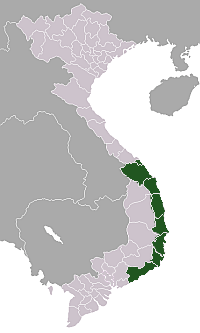Vân Canh District
| Vân Canh District Huyện Vân Canh | |
|---|---|
| District | |
|
| |
| Country |
|
| Region | South Central Coast |
| Province | Bình Định |
| Capital | Vân Canh |
| Area | |
| • Total | 800 km2 (300 sq mi) |
| Population (2009)[1] | |
| • Total | 24,600 |
| • Density | 31/km2 (80/sq mi) |
| Time zone | UTC + 7 (UTC+7) |
Vân Canh is a rural district (huyện) of Bình Định Province in the South Central Coast region of Vietnam. The district capital is Vân Canh.[2] Vân Canh is a mountainous district, located in the southwest of Bình Định Province, and is relatively sparsely populated.
Geography
Vân Canh borders Đồng Xuân District of Phú Yên Province to the south, the districts of An Nhơn, Tây Sơn and Tuy Phước to the north, and Kông Chro District of Gia Lai Province to the west.
Hà Thanh River has its source and flows through the district.
Administrative divisions
There are seven administrative units at communal level, in which the town of Vân Canh was established and in addition to the communes of Canh Hòa, Canh Thuận, Canh Hiệp, Canh Hiển, Canh Vinh and Canh Liên.
Demography
There are three ethnic groups living in the district, Kinh, Cham people and BaNa. The Cham are mainly concentrated mainly in Canh Hoà, Bana ethnic concentration in Canh Liên, Canh Thuận, Canh Hiệp, where they exceed 40% of the total population.
The Cham people settled in the mountainous area along with the indigenous tribes after the kingdom of Champa was dismantled in 1471. As a result, the Cham have adopted many facets of Bana culture.
Transport and economy
Most of the communes of Vân Canh District lie on the provincial road 638 between Diêu Trì and Phú Yên Province. Transport facilities have been improved in recent years, allowing increasing economic activity and development. However, infrastructure in the remote Canh Lien commune in the west of the district is still primitive.
Vietnam's North–South Railway passes through this district. However, there is no railway station.[3]
The standard of living is low, and the poverty rate high. The land is rather infertile and a lack of irrigation water compounds the poor productivity. In recent years, the sugar cane industry has developed substantially, and the sugar cane factory of Binh Dinh has grown, producing more economic opportunities. The area has a lot of idle grassland that can be exploited for grazing. The area has abundance of natural forests as well as planted ones.
References
- ↑ Bình Định Statistics Office (2010): Bình Định Statistical Yearbook 2009. Statistical Publishing House, Hanoi
- ↑ "Districts of Vietnam". Statoids. Retrieved March 13, 2009.
- ↑ Viet Nam Administrative Atlas. Cartographic Publishing House, Hanoi 2010
Coordinates: 13°40′01″N 108°55′01″E / 13.667°N 108.917°E
